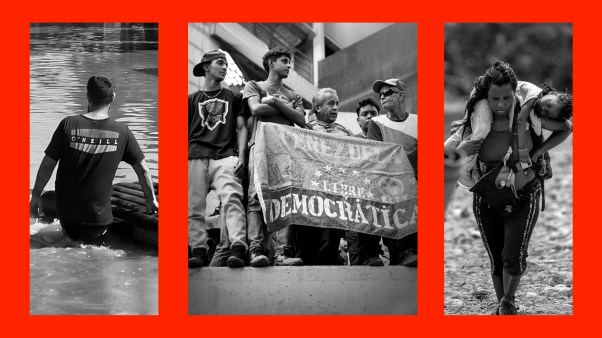We live in an era of political divisions. There is the gender gap. There is the race gap. There is also the so-called “God gap.” Americans with no religion are more likely to be Democrat, and religious voters are more likely to be Republican. But new research suggests that the reason for the God gap may not be as simple as most people think.
From Politics to the Pews: How Partisanship and the Political Environment Shape Religious Identity (Chicago Studies in American Politics)
University of Chicago Press
336 pages
$32.04
In her book From Politics to the Pews, University of Pennsylvania professor Michele F. Margolis examines why the God gap exists. Typically, we imagine that this gap results from religious people finding a home, disproportionately, in the Republican Party, while more secular people do likewise with the Democratic Party. As Margolis explains it, however, the pattern sometimes runs in the opposite direction: People with fixed political beliefs sort themselves into religious categories, at least partly on the basis of those very beliefs. The story Margolis unpacks is complicated, but it also compelling, with implications for how we understand both religion and politics in America.
When Identities Form
The God gap is not about evangelicals or other conservative religious groups per se. Among Protestants, Catholics, and other groups, we see a political divide between those who are more religious and the “nones,” those who do not identify with any religion or do not practice a religion. In the 2018 midterms, voters who were “nones” gave Republicans only 28 percent of their votes. Voters who were part of a religion, on the other hand, split their votes 50-50 between the parties’ candidates.
This pattern reflects a long-standing divide in how people see themselves politically. Each presidential election year, the American National Election Study (ANES) conducts the most extensive—and expensive—study of the American electorate. In 2016, the ANES found that 52 percent of Americans who never went to church identified themselves as Democrats; only 30 percent were Republicans. For those who attended church at all, 42 percent were Democrats and 46 percent were Republicans. This gap of 10-15 points is consistent with the God gap of the past several elections.
The most common explanation for the God gap was simple. Religious Americans were attracted to the Republican Party because of its positions on abortion, sexuality, and other social issues. Those with no religion, particularly those who had left religion, were pulled into the Democratic Party. It was a simple explanation, but it was also one that had not been rigorously tested. There was a correlation between religion and partisanship, but, as the saying goes, correlation is not causation.
This is why Margolis’s work is so important—it helps unravel this chicken-and-egg puzzle.
Margolis does not find that being religious is always driven by partisanship. It is more complicated than that. She finds that there is a time in life when people are most susceptible to having their religion shaped by partisanship. When parties are divided over issues with deep religious meaning, partisans in this phase in life will sort themselves into religious groups based on their politics.
We often like to think of our religious identities as being more fundamental than our political identities. That is often not the case. In the case of the typical American, we figure out our political identities during adolescence (age 10 through the early 20s). After that, our partisan identities are more or less locked in. If you’re a Republican by your mid-20s, then you’re likely to remain a Republican the rest of your life.
Religious identities are not baked in as early in life. In adolescence, we often rebel against the religion of our childhood, consider other religions, or live on the periphery of a religious community. Unlike partisanship—which is an identity requiring little action other than voting—religion requires a daily commitment. There are dos and don’ts that may be inconvenient to one’s work, relationships, or other pursuits.
When does a person’s religious identity become more-or-less permanent? For many it is when they have young children. During this time, adults cannot ignore their moral and spiritual beliefs. They need to decide how they want to raise their children and what role, if any, religion will play.
It’s at this stage in life, Margolis finds, when partisanship can shape religious identity. With their partisanship fixed years earlier, adults factor in their political beliefs as they decide whether or not to be religious. Partisanship is not the only factor, to be clear, but it can play a part in influencing one’s religious trajectory.
The Religious Right’s ascendancy in the Republican Party—coupled with the party’s embrace of socially conservative stances on issues like abortion—changed perceptions of the parties. Unlike the GOP of old, Republicans increasingly came to be seen as God’s Own Party. The Democratic Party, on the other hand, took more liberal positions on issues of concern to religious voters and embraced religious pluralism. Americans (particularly white Americans) increasingly saw Republicans as the party more aligned with religion.
Using a unique set of surveys that tracked voters over decades, Margolis finds that Republicans were more likely to become more religious once they had young children. Democrats, however, were not. In other words, it’s not that Democrats left religion so much as Republicans became more religious because they were Republicans. The God gap, at least to some extent, was driven by partisanship, not religion.
Remember the Caveats
A key part of this explanation is that people must perceive the Republican Party as friendlier toward religion than the Democratic Party. Margolis finds that people need to be knowledgeable about politics for partisanship to drive their religious involvement.
Race is also important. Margolis reports that while about two-thirds of white Democrats and white Republicans see the Republican Party as more religious, only one-quarter of blacks see the GOP this way. In the eyes of many blacks, Republican positions on abortion, sexuality, and other social issues do not compensate for a perceived failure on issues of justice and racial equality. As a result, the partisan-driven sorting into religious categories is not found among blacks; it is primarily an explanation for division among whites.
Margolis does an excellent job of examining the implications of her research and unpacking the complexities. My fear, however, is that readers won’t take these nuances as seriously as the author does. It would be simplistic to describe this book as arguing that people choose religion because of politics. It does show that, but with several important caveats: The partisan effect occurs among certain people at a certain stage in life, specifically white partisans with young children and a keen understanding of politics. By contrast, partisanship has a much smaller effect (if any) on the religion of blacks, older Americans, younger adults, political independents, and those who know little about politics.
From Politics to the Pews is a thoroughly researched and nuanced book that may be too detailed for the casual reader. It presents Margolis’s research in a manner useful for convincing other researchers. That said, it is well-written and accessible, and it expands our understanding of why people are religious and how politics can shape religious identities.
Tobin Grant teaches political science and sociology at Southern Illinois University.









